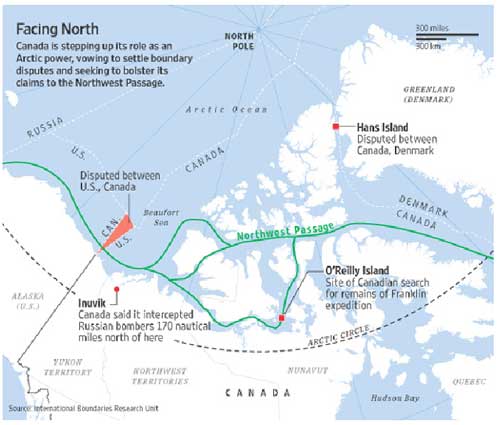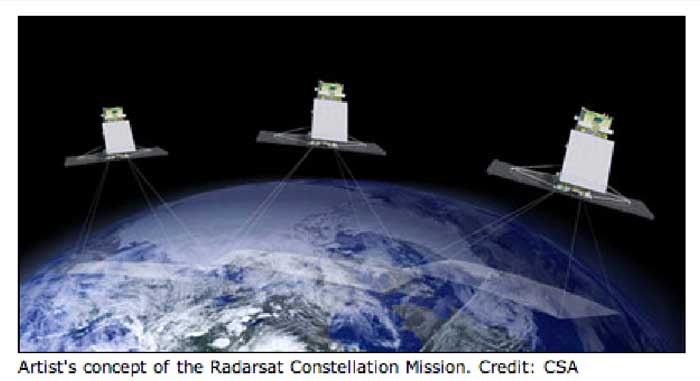Lessons from Canada and The Way Ahead
By Caroline Mükusch
German Correspondent, Second Line of Defense
12/21/2010 – In order to meet the Arctic challenges and opportunities of the 21st century Canada formulated a comprehensive Northern Strategy in 2009. Underpinned by science and technology progress the Canadian Northern Strategy pursues a pro-active Arctic policy focusing on four priority areas:
- Exercising their Arctic sovereignty.
- Protecting their environmental heritage.
- Promoting social and economic development.
- Improving and devolving northern governance.
Canada’s Northern Strategy reflects Arctic sovereignty and security. Canada’s concept of Arctic sovereignty and security is equivalent to the defense of Canadian Arctic sovereignty for the purpose of protecting the security of its citizens as well as the security of the core values and interests of Canadians. While sovereignty is especially about control, security is about responding to threats.
 (Credit image: http://online.wsj.com/article/SB10001424052748703369704575461832760265748.html)
(Credit image: http://online.wsj.com/article/SB10001424052748703369704575461832760265748.html)
With the collapse of the Soviet Union, Canada could no longer assume that the high northern latitudes of Canada would be protected by the U.S. Canada developed a whole-of-government approach addressing all three driving factors of the Arctic: (1) environmental change, (2) resource development, and (3) geopolitical transformation. Canada’s approach acknowledges furthermore the complicating, interacting reality of these factors. Therefore, Canada put a lot of effort into:
- Knowing what is happening in the Canadian north;
- Enforcing Canadian rules and laws; and
- Cooperating with Canada’s circumpolar neighbors.
Since 2009 Canadian Arctic policy also has an international dimension. In 2009, the U.S. Coast Guard, the U.S. Second Fleet, and the Royal Danish Navy participated in the Operation Nanook to strengthen the preparedness and inter-operability, exercising a collective response to emerging challenges in the Arctic.
Operation Nanook – an Arctic expedition undertaken first by the U.S. Navy in 1946 – is one of three (since 2007) annually proceeding joint exercises of Canada’s Maritime Command and the Canadian Coast Guard to train for disaster and sovereignty patrols in the Arctic.

To improve its capabilities to better monitor, protect and patrol in the Arctic land, sea, and sky, Canada provides the Canadian Forces with the Canada First Defense Strategy tools to show increased presence in the Arctic. Beside three armed icebreakers operated by the navy, Canada built six to eight Arctic offshore vessels and a large icebreaker; developed an indigenous surveillance capability (Northern Watch and RadarSat II; Polar Epsilon); expanded the Rangers, creating a Northern Reserve Unit based in the Arctic, developed an army Arctic training base in Resolute; restored berthing and refueling facility in Nanisivik; provided new patrol ships to the Coast Guard; and developed a deepwater resupply port in Nanisivik.
Canada is boosting both defense and science facilities to further promote Canada’s power and influence in the Arctic at a number of different levels. Both, new research infrastructures such as the High Arctic Research Station in Cambridge Bay as well as military training such as the annual northern sovereignty exercises strengthen the Canadian sovereignty strategy. Especially science and technology measures are on the one hand helpful for economic and social development, and on other hand they are fulfilling the function of presence in the area.
The Way Ahead
The operational environment of the Arctic remains challenging: The Arctic is an area of high fuel resource potential, high geologic uncertainty, and sensitive environmental conditions. On the one hand the Arctic is – because of lacking infrastructure – a very expensive region to operate in; on the other hand gathering data, generating information superiority, and enhancing international recognition are the key components establishing the necessary political, economical, and environmental stability in this area.
Although, a direct (military) threat in the Arctic does not exist now, the indicators are becoming more and more worrisome. Lacking a comprehensive European Arctic policy the EU is neither able to secure and protect its strategic interests such as energy security nor able to support both its member states as well as allies in securing their legitimate interests and rights in the Arctic. But, they need to support their member states and allies, to control the region.
Europe must be prepared to deal with challenges of the 21st century Arctic power game, in a concise and effective manner. Otherwise, any conflict over resources or boundaries will probably result in huge environmental damage to the region that affects Europe directly.

